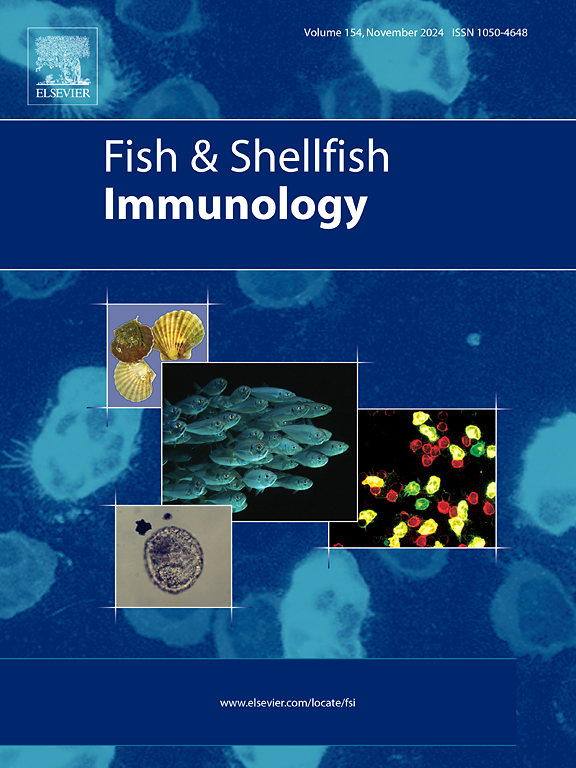了解植物乳杆菌的益生潜力:对马尼拉蛤蜊 Ruditapes philippinarum 的抗氧化能力、非特异性免疫力和肠道微生物群的改善作用。
IF 4.1
2区 农林科学
Q1 FISHERIES
引用次数: 0
摘要
乳酸菌(LAB)对水生动物有益,能改善它们的免疫系统和肠道微生物群。然而,人们对植物乳酸菌对马尼拉蛤蜊(Ruditapes philippinarum)的益生菌作用仍然知之甚少。本文评估了在饲养水中添加最终剂量为 1 × 105 CFU/L(T5 组)、1 × 107 CFU/L(T7 组)和 1 × 109 CFU/L(T9 组)的植物乳杆菌八周对菲利宾氏蛤抗氧化能力、非特异性免疫、抗副溶血性弧菌感染和肠道微生物群的影响。不添加植物乳杆菌的饲养水作为对照。结果表明,T7 和 T9 组的蛤蜊对副溶血性弧菌的抗病能力、肝胰脏中碱性磷酸酶和溶菌酶的活性以及抗氧化和免疫相关基因(包括 SOD、GPx 和 GST)的表达均有显著提高。同时,T7 组的超氧化物歧化酶、过氧化氢酶活性和 CAT 表达量显著提高,而 T9 组的还原型谷胱甘肽含量显著增加。只有过氧化氢酶活性在 T5 组有明显提高。副溶血性弧菌感染后,三个处理组的 SOD、CAT、GPx 和 GST 表达量均显著增加。T7 组的肠道微生物群丰富度明显增加。所有三个处理组的固有菌群和 T5 和 T7 组的放线菌群数量都有显著增加。此外,机会致病菌埃希氏菌在三个治疗组中的数量显著减少。此外,施用 1 × 107 CFU/L 的植物乳杆菌可增强肠道微生态系统的稳定性,而 1 × 109 CFU/L 的剂量则可能会产生负面影响。应用三种剂量的植物乳杆菌可显著增强肠道微生物群与免疫反应和氧化应激调节相关的功能,而较高剂量(1 × 109 CFU/L)可能会抑制多种功能。总之,在饲养水中添加植物乳杆菌对菲利宾纳氏鲤的抗氧化能力、非特异性免疫力、对副溶血性弧菌的抵抗力以及肠道微生物群的稳定性和功能都有益处。植物乳杆菌对菲利宾纳氏菌的有益作用与剂量有关,最终剂量为 1 × 107 CFU/L 时效果最佳。本文章由计算机程序翻译,如有差异,请以英文原文为准。
Understanding the probiotic potential of Lactobacillus plantarum: Antioxidant capacity, non-specific immunity and intestinal microbiota improvement effects on Manila clam Ruditapes philippinarum
Lactic acid bacteria (LAB) have beneficial effects on aquatic animals, improving their immune system and intestinal microbiota. Nevertheless, the probiotic effects of LAB on the Manila clam Ruditapes philippinarum remain poorly understood. Herein, the effects of administering Lactobacillus plantarum at final doses of 1 × 105 CFU/L (T5 group), 1 × 107 CFU/L (T7 group), and 1 × 109 CFU/L (T9 group) in the rearing water for eight weeks were evaluated for the antioxidant capacity, non-specific immunity, resistance to Vibrio parahaemolyticus infection, and intestinal microbiota of R. philippinarum. The rearing water without the addition of L. plantarum served as a control. The results showed that the T7 and T9 groups demonstrated a significant elevation in the disease resistance of clams against V. parahaemolyticus, in the activities of alkaline phosphatase and lysozyme in the hepatopancreas, and in the expression of antioxidant- and immune-related genes, including SOD, GPx, and GST. Meanwhile, the T7 group showed a significant enhancement in superoxide dismutase and catalase activities and CAT expression, while the T9 group experienced a remarkable elevation in reduced glutathione content. Only catalase activity was markedly elevated in the T5 group. The expression of SOD, CAT, GPx, and GST was significantly elevated in three treatment groups following the V. parahaemolyticus challenge. The T7 group exhibited a significant increase in intestinal microbiota richness. Significant increases were noted in Firmicutes abundance across all three treatment groups and in Actinobacteriota in the T5 and T7 groups. Additionally, the opportunistic pathogen Escherichia-Shigella abundance significantly decreased in three treatment groups. Furthermore, administration of 1 × 107 CFU/L L. plantarum enhanced the stability of the intestinal microecosystem, whereas a dose of 1 × 109 CFU/L might have a negative effect. The application of three doses of L. plantarum significantly enhanced intestinal microbiota functions related to the immune response and oxidative stress regulation, while a higher dose (1 × 109 CFU/L) might inhibit several functions. In conclusion, the application of L. plantarum in the rearing water exerted beneficial effects on the antioxidant capacity, non-specific immunity, resistance to V. parahaemolyticus, and the intestinal microbiota stability and functions of R. philippinarum. The beneficial effects of L. plantarum on R. philippinarum were dose-dependent, and the final dose of 1 × 107 CFU/L exhibited the optimal effects.
求助全文
通过发布文献求助,成功后即可免费获取论文全文。
去求助
来源期刊

Fish & shellfish immunology
农林科学-海洋与淡水生物学
CiteScore
7.50
自引率
19.10%
发文量
750
审稿时长
68 days
期刊介绍:
Fish and Shellfish Immunology rapidly publishes high-quality, peer-refereed contributions in the expanding fields of fish and shellfish immunology. It presents studies on the basic mechanisms of both the specific and non-specific defense systems, the cells, tissues, and humoral factors involved, their dependence on environmental and intrinsic factors, response to pathogens, response to vaccination, and applied studies on the development of specific vaccines for use in the aquaculture industry.
 求助内容:
求助内容: 应助结果提醒方式:
应助结果提醒方式:


